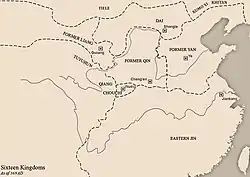Former Yan (前燕) 燕 | |||||||||||||||
|---|---|---|---|---|---|---|---|---|---|---|---|---|---|---|---|
| 337–370 | |||||||||||||||
.jpg.webp) Former Yan in 338 AD | |||||||||||||||
 Former Yan in 369 AD | |||||||||||||||
| Capital | Jicheng (棘城) (337–341) Longcheng (341–350) Jicheng (薊城) (350–357) Yecheng (357–370) | ||||||||||||||
| Government | Monarchy | ||||||||||||||
| Emperor | |||||||||||||||
• 337–348 | Murong Huang | ||||||||||||||
• 348–360 | Murong Jun | ||||||||||||||
• 360–370 | Murong Wei | ||||||||||||||
| History | |||||||||||||||
• Murong Huang's claim of princely title | 23 November 337[1][2] 337 | ||||||||||||||
• Murong Jun's claim of imperial title | 4 January 353[3][4] | ||||||||||||||
• Fall of Yecheng | 11 December 370[5][6] | ||||||||||||||
• Disestablished | 370 | ||||||||||||||
| |||||||||||||||
| Today part of | China | ||||||||||||||
The Former Yan (Chinese: 前燕; pinyin: Qián Yān; 337–370) was a dynastic state ruled by the Xianbei during the era of Sixteen Kingdoms in China.
Initially, Murong Huang and his son Murong Jun claimed the Jin dynasty-created title "Prince of Yan," but subsequently, in 352, after seizing most of the former Later Zhao territory, Murong Jun would declare himself emperor, and after that point, the rulers of the Former Yan declared themselves "emperors".
History
During the winter of 342, the Xianbei of Former Yan, ruled by the Murong clan, attacked and destroyed Goguryeo's capital, Hwando, capturing 50,000 Goguryeo men and women to use as slave labor in addition to taking the queen mother and queen prisoner,[7] and forced King Gogukwon to flee for a while. The Xianbei also devastated Buyeo in 346, accelerating Buyeo migration to the Korean peninsula.[8]
Initially the capital city was Jicheng 棘城 (also known as Dajicheng),[9] then Yan (Beijing) in 350, then Yecheng in 357, and finally Luoyang in 364.[10]
 Painting depicting a Xianbei Murong archer in a tomb of the Former Yan (337–370).[11]
Painting depicting a Xianbei Murong archer in a tomb of the Former Yan (337–370).[11]
Rulers of the Former Yan
| Temple names | Posthumous names | Family names and given name | Durations of reigns | Era names and their according durations |
|---|---|---|---|---|
| Chinese convention: use family and given names | ||||
| Taizu (太祖 Taìzǔ) | Wenming (文明 Wénmíng) | 慕容皝 Mùróng Huǎng | 337–348 | Yanwang (燕王 Yànwáng) 337–348 |
| Liezong (烈宗 Lièzōng) | Jingzhao (景昭 Jǐngzhāo) | 慕容儁 Mùróng Jùn | 348–360 | Yanwang (燕王 Yànwáng) 348–353 Yuanxi (元璽 Yuánxǐ) 353–357 Guangshou (光壽 Guāngshoù) 357–360 |
| Did not exist | You (幽 Yōu) | 慕容暐 Mùróng Wěi | 360–370 | Jianxi (建熙 Jiànxī) 360–370 |
See also
References
- ↑ "兩千年中西曆轉換". Sinica.edu.tw. Retrieved 2011-08-03.
- ↑ Zizhi Tongjian, vol. 95.
- ↑ "兩千年中西曆轉換". Sinica.edu.tw. Retrieved 2011-08-03.
- ↑ Zizhi Tongjian, vol. 99.
- ↑ "兩千年中西曆轉換". Sinica.edu.tw. Retrieved 2011-08-03.
- ↑ Zizhi Tongjian, vol. 102.
- ↑ Chinul (1991). Buswell, Robert E. (ed.). Tracing Back the Radiance: Chinul's Korean Way of Zen. Translated by Robert E. Buswell (abridged ed.). University of Hawaii Press. p. 4. ISBN 0824814274. Retrieved 22 April 2014.
- ↑ Tennant, Charles Roger (1996). A History of Korea. Routledge. p. 22. ISBN 9780710305329. Retrieved 10 October 2016.
Soon after, the Wei fell to the Jin and Koguryŏ grew stronger, until in 313 they finally succeeded in occupying Lelang and bringing to an end the 400 years of China's presence in the peninsula, a period sufficient to ensure that for the next 1,500 it would remain firmly within the sphere of its culture. After the fall of the Jin in 316, the proto-Mongol Xianbei occupied the North of China, of which the Murong clan took the Shandong area, moved up to the Liao, and in 341 sacked and burned the Koguryŏ capital at Hwando. They took away some thousands of prisoners to provide cheap labour to build more walls of their own, and in 346 went on to wreak even greater destruction on Puyŏ, hastening what seems to have been a continuing migration of its people into the north-eastern area of the peninsula, but Koguryŏ, though temporarily weakened, would soon rebuild its walls and continue to expand.
- ↑ Schreiber, Gerhard (1949). "The History of the Former Yen Dynasty". Monumenta Serica. doi:10.1080/02549948.1949.11730940.
- ↑ Grousset, Rene (1970). The Empire of the Steppes. Rutgers University Press. pp. 58. ISBN 0-8135-1304-9.
- ↑ Hong, Wontack (2005). "Commencing the Dual System: the Yan Kingdom of Mu-rong Xianbei" (PDF). East Asian History: A Korean Perspective.